#nutritional product manufacturer
Text
#titus health tech#how to feed a newborn#how to prepare infant formula#new born nutrition products#nutritional solutions for new borns#nutrition products#infant formula#nutritional supplement manufacturing#nutritional products manufacturers#nutritional supplements products#private label nutrition manufacturers#nutritional product manufacturer#nutritional solutions for new-borns#gym nutrition products#nutrition for pregnant women#infant nutrition products manufacturer#infant formula products#infant milk food manufacturers
1 note
·
View note
Text

ALWAYS YOU ARE YOUNGER BUT 30+ YEARS LATER WILL SEE HOW MAINTAIN CLICK HERE
#problem is#aizen power#supplement products#nutrition#formula e#sexy belly#sexy tease#mensproducts#sperm donation#spermshower#shot#confidence#little penis#protein#benefits#nutritional#supplement manufacturer#nutrients
4 notes
·
View notes
Text
Discover India's premier destination for high-quality third-party manufacturing services in the nutraceutical industry. Maxwell Business excels in producing premium nutraceutical products, including food supplements, sports nutrition, dietary supplements, health supplements, and protein powders, at affordable pricing.
#Nutraceutical Manufacturers India#Top Dietary Supplement Manufacturers#Third-Party Nutraceutical Production#High-Quality Nutraceutical Products#Maxwell business#Premium Food Supplements#Sports Nutrition Suppliers#Dietary Supplement Manufacturers#Health Supplement Production#Protein Powder Manufacturers#Best Nutraceutical Companies in India#Reliable Nutraceutical Suppliers#Affordable Nutraceutical Pricing#Indian Nutraceutical Industry#Leading Nutraceutical Manufacturers
0 notes
Text
#JH BIO -Leading chinese multinational manufacturer and distributor of feed ingredients with years of experience in the animal nutrition#feed industries of worldwide. Being a biotecnology company has not only taught us to focus on supplying the best products#but also to offer a dedicated and sincere service at all times to our customers. From product quality and safety#with an understanding of pricing according to market conditions and trends#to global delivery service and on-time transportation.
1 note
·
View note
Text
Ayurorganic is best choice for healthy and organic products
Ayurorganic started its quest 20 years back and our aim was crystal clear since the beginning – To become a pioneer of organic across the globe’. Since 2003, Ayur Pty Ltd has been at the top of Australia's list of distributors and marketers of pure and unadulterated organic ingredients over a broad range. The initial phase was tough for us as the Australian market was completely unaware of this concept but we took it upon ourselves to train & educate people about organic products.
We were the first company to venture into the business of manufacturing & trading agricultural products and we also carved a niche in this field by adopting a six-tier approach for Total Quality Management. At present, we are one of the leading manufacturers of organic & conventional seeds, spices, grains, cereals & pulses, hair care, skin care, oral care, food, oil, and many more.
Our vision is to establish a worldwide network of satisfied clients & to provide natural, healthy & 100% organic produce to the world.
We aim to epitomize Life and Sustainability and encourage a positive change in the lifestyle of people around us.
Our organic products are void of toxic chemicals, rich in nutrition & sustainable in nature. With us, you will get access to a wide variety of organic products like Ajwain seeds, Flax seeds, Sesame seeds, Psyllium, Black Pepper Yellow Mustard Seeds, Black Mustard seeds, Pulses, Grains, Claiming Organic tea, Ashwagandha Jam Organic, Castor Oil Organic, Herbs and a lot more.
For those looking for gluten-free food products, We’re a great choice. It also gives you the choice of ordering your preferred organic food products online.
We are renowned for supplying the cleanest organic food items possible, ones that were grown without the use of any hazardous pesticides or chemicals. You can get cereals, honey, pulses, and many more.
The best part is you can buy the products of this brand from online stores and that too at very reasonable rates with online offers. We’re one of the most popular organic food product brands in Australia.
Ayurorganic is redefining the definition of good living to one nourished by organic and natural products that are sourced ethically and farmed sustainably. Ayurorganic food is the best in Australia. The popularity of organic products and foods has increased significantly. The terminology “organic” is indeed a reference to how different foods are processed as well as grown before they enter the consumer market. Our journey started in 2003, with a rather ambitious plan to use tradition and technology to bridge the gaps in the dietary habits of our people
Ayurorganic is a pioneer in manufacturing organic and nutritional products using a wide variety of broad diverse crops. Our products range from organic baby food to critical nutrition. Ayurorganics is deeply embedded in nutritional research and designer diet formulations. With experience in research and development, it has been able to offer nutraceuticals, functional foods, and medical and metabolic diets. The products cater to a host of health conditions in terms of their prevention and management.
Visit our official website or call us at 03 83618103
#nutritional products#manufacturing organic and nutritional products#organic baby food#cleanest organic food
0 notes
Text
Beta Carotene Supplements | Beta Carotene Powder - Bio-Gen Extracts
Beta carotene, a type of vitamin A, has been shown to be helpful in reducing the risk of some types of cancer. Some people take beta carotene supplements to gain these benefits. Supplements can be bought over the counter or through a doctor.
Beta carotene supplements are products that contain beta carotene, a vitamin A precursor. They are often taken by people who want to increase their intake of this important nutrient. Beta carotene is a chemical that the body can convert into vitamin A. This means that it can help prevent certain diseases and improve overall health.
Beta carotene is a yellow pigment that is found in plants. Some people take beta carotene supplements to get more of the pigment in their diet. Beta carotene may help protect the skin against sun damage and may help keep the skin healthy.
What are beta carotene supplements and what do they do?
Beta carotene is a yellow pigment found in plants. Beta Carotene Supplements It is converted to vitamin A in the body, and is thought to help protect against some types of cancer. Many supplements contain beta carotene, and it is often marketed as a way to improve your vision. However, there is little evidence that beta carotene supplements actually improve your vision.
Beta carotene is a type of vitamin found in fruits and vegetables. It’s important for your body to make this vitamin because it helps your eyesight. Some people take beta carotene supplements to improve their vision.
Types of beta carotene supplements: isolated and synthetic
There are two types of beta carotene supplements: isolated and synthetic. Isolated beta carotene is found in plants, Beta Carotene Powder while synthetic beta carotene is a mixture of two or more chemical compounds. Synthetic beta carotene is usually cheaper because it doesn't need to be extracted from natural sources. However, synthetic beta carotene may have unknown side effects.
Beta carotene supplements come in two types: isolated and synthetic. Isolated beta carotene is found in natural sources, like fruits and vegetables, while synthetic beta carotene is a manufactured product. Both have been shown to have health benefits, but synthetic beta carotene may be more effective than isolated beta carotene. Synthetic beta carotene may also be less expensive than isolated beta carotene.
How beta carotene supplements work: antioxidant and anti-inflammatory effects
Beta carotene is an antioxidant that has both anti-inflammatory and antioxidant effects. It is most commonly found in fruits and vegetables, but can also be found in supplements. Some studies have shown that beta-carotene may help protect the heart, lungs, and skin from damage.
Beta carotene is a type of antioxidant that helps protect cells from damage. It also has anti-inflammatory effects, which can reduce the risk of heart disease, arthritis, and other inflammatory conditions.
Beta carotene is a natural antioxidant and anti-inflammatory agent. It can help improve the health of the skin, lungs, heart, and blood vessels. Some people take beta carotene supplements to increase their vitamin A levels.
Safety of beta carotene supplements: potential side effects
Beta carotene supplements are widely available and marketed as a way to improve the health of people who are at risk for heart disease. However, there is no evidence that beta carotene supplements are safe or effective. In fact, there is some evidence that beta carotene supplements may be associated with harmful side effects.
Side effects of beta carotene supplements can include liver damage, lung problems, and even death. These side effects can occur even if you take low doses of beta carotene supplements, which suggests that the benefits of beta carotene supplementation may not outweigh the risks. If you are considering using a beta carotene supplement, it is important to talk to your doctor about the potential risks and benefits of using this type of supplement.
Conclusion
In conclusion, beta-carotene may be helpful in reducing the risk of some types of cancer. Some people take beta carotene supplements to gain these benefits. If you are concerned about your cancer risk, speak with your doctor about whether or not taking a beta carotene supplement could benefit you.
For More Information @ Bio-gen Extracts Private Limited
Bio-gen House, 254/1-9, 3rd Floor, 11th Main Road, 3rd Phase, Peenya Industrial Area, Bangalore 560 058, Karnataka INDIA
Reach Us : +91 91089 93618 / +91 91080 58822
0 notes
Link
#nutraceuticals#nutraceutical supplements#nutraceutical product development#nutraceutical formulation#nutraceutical formulation development#dietary supplements#food supplements#nutritional supplements#nutraceutical contract manufacturing#foodresearchlab#Functional Foods#new functional food#nutraceutical product development solutions
0 notes
Text


Republican hostage demands include:
Increasing and not cutting the defense budget, nor the Border Patrol budget
Cut funding to the following programs and agencies by 51 percent: Supplemental Nutrition Assistance Program (SNAP), the Social Security Administration, Environmental Protection Agency, Veteran’s Assistance Program, Health and Human Services, Department of Education, Department of Housing and Urban Development, the Justice Department, the State Department, the Department of Transportation, NASA, the Labor Department, and more (source)
Rescind any student loan relief and make borrowers pay back any payments that were paused or recently forgiven
Defund the IRS so that it cannot go after wealthy tax evaders
New, harsher work requirements for Medicaid recipients
Raise the work retirement age for people enrolled in the SNAP, from 50 to 55 years old
More stringent work requirements for food stamp recipients
Deregulation of drilling and mining permitting
Repeal any tax breaks that encouraged using renewable energy sources
Pledges to increase domestic production of oil and other fossil fuels
In short, the Republican demands to raise the debt ceiling is a manufactured crisis. It’s yet another GOP wish list to attack poor people by eviscerating the social safety net, while simultaneously deregulating big businesses and defunding the government agencies that could hold polluters and exploiters accountable
👉🏿 https://www.pbs.org/newshour/politics/heres-whats-in-the-gop-bill-to-lift-the-u-s-debt-limit
👉🏿 https://www.dataforprogress.org/blog/2022/12/12/voters-want-congress-to-raise-the-debt-ceiling-and-protect-social-programs
👉🏿 https://www.cbsnews.com/amp/news/debt-ceiling-house-republicans-bill-limit-save-grow-act/
113 notes
·
View notes
Text
Transparency With Parrot Food Manufacturers
There's been a significant rise in the expectation of transparency between pet food manufacturers and the general public. Dog food manufacturers, for example; have AAFCO, feeding trials, and an array of nutrient digestibility charts, base nutrient expectations, and sanitary guidelines to follow which a lot of brands then openly share with the public. These standards help pet parents make more active choices in what they feed their pets, tailor their pets diet to meet their individual needs, trust that their food meets a base line of nutrition, and that the food was produced in a sanitary manner. The dog food industry is far from perfect and even these regulations have their flaws and the tests aren't without fault but it is a good base for us to compare to when we're trying to sort out what we want from other pet food manufacturers. In this case I'm focusing on parrot pellet manufacturers.
I had a few different goals heading in to this.
I wanted to see how transparent pellet manufacturers would be with sharing information that is common to ask dog food manufacturers (information is not confidential, revealing formulas, secrets, etc.)
The availability of nutrient analysis charts (breakdowns of how much of each nutrient is in their pellets)
What standards parrot food manufacturers held themselves to
If any feeding trials were performed on their pellets
And to preface this with my own bias, I am pro-pellet, I currently feed pellets.
Before we get too deep in to this let's break things down a bit.
As it stands there really aren't any regulating bodies above parrot food manufacturers as far as I could find. There doesn't seem to be much of any standards when it comes to their sanitization or product quality, the best you get is the FDA/ CFIA which basically just make sure a food isn't outright toxic. As it stands there haven't been enough studies done on parrot nutrition for there to be a governing body stating what the minimum nutrient requirements are for parrot food, we simply do not actually know what those requirements are yet so there cannot be a set standard for it. This unfortunately leaves us open to a lot of problems, if there's no nutritional requirements and no standardized testing then we're really just putting a lot of trust in to a company that wants to turn a profit. We're hoping that the food that says it's nutritionally complete is what it says with no evidence to show for it, and no science to confirm it.
So with that said no parrot food can actually claim to be "100% nutritionally complete", we do not know what nutritionally complete looks like for parrots, there is no science to back up those claims.
So I set out and emailed every parrot pellet manufacturer I could think of and asked them the some questions.
"Does your company do feeding trials? If so, is that data available to the public anywhere?"
"Do you have a nutrient profile available?"
Feeding trials are very simply a test where you feed a set of animals exclusively one diet and then monitor them to see if the food is capable of providing the base essential nutrients needed to live. Usually they do blood work, urine and fecal alongside regular physical exams to monitor things like nutritional deficiency, ailments, and nutrient digestibility. This helps show that a food is capable of providing what the target animal needs to survive without causing health problems and provides vital information on what amount of vitamins/ minerals in the produced food are actually being digested and absorbed. These tests are common among well-known dog food companies and most are more than willing to share that data to give their consumers peace of mind with easy transparency.
And let me tell you I am beyond disappointed at what happened when I asked parrot food manufacturers the exact same thing.
TOPs: No nutrient profile listed on the website, does have a detailed breakdown of why every single ingredient was added though. Happily discloses that parrot nutritional science doesn't have all the data to claim any food as 100% nutritionally complete and advises for the feeding of fresh foods in addition to their food, didn't specify exactly how much of each to maintain optimal nutrition.
I emailed them three times and never got a response back from any of them.
Harrisons: Does say you can feed 20% vegetables by weight while the pellet should be 75%, has an easily available nutrient analysis on their website.
also emailed three times with no response back.
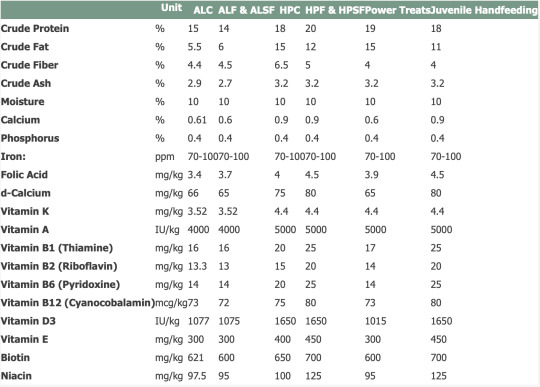
Caitec: no nutritional analysis listed on their main website, website did not state how they want their product to be fed, product packaging states that veggies should be a treat/ addition and lists the pellet as a "complete diet".
emailed three times with no response back.
Lafeber: Primarily promotes mixed seed and pellet formulas, doesn't state any risks of parrot's selective consumption (study on that problem), does promote the feeding of fresh produce in conjunction with their formulas at 20% of the diet, no nutrient analysis on their website.
emailed three times with no response back.
Zupreem (Compana Pet Brands): did respond back but they phrased their response in a way to dance around the subject, after some pushing they confirmed they do not do feeding trials. Encourages use of fresh foods with their formula, at least 60% pelleted diet recommended. Had an extremely small nutrient profile that just skipped over the important nutrient requirements like the Ca:Ph. I asked for a nutrient profile which they did not want to provide but were able to tell me that the naturals pellets have 0.59% calcium

Roudybush: Says fresh foods can be fed but "as a minor part of the diet", does say that science doesn't have enough information to make a product tailored to each species of bird, did make changes to their formula recently to remove menadione in favour of alfalfa due to it's potential toxicity. does seem to be evolving as science progresses. Ingredients list wasn't listed on the website, nor was a nutrient profile.
did not reply to any emails.
Tropican (HARI): I was hopeful for this one by the way their website boasts about their feeding trials and research. So so hopeful.
Talks about doing feeding trials openly on their website, recommends 70% pellet to 30% fresh foods (by caloric content not weight) but mentioned that their birds eat 100% pellets. Easily accessible albeit basic nutrient profile but it covers the main things.

After my email Mr. Hagen actually ended up calling me and what I was hoping would be a motivating call ended up being very hostile. Whenever I asked questions about data or results of a feeding trial I was immediately shut down, the topic was changed, I was interrupted mid-sentence over and over again. I was able to get small tidbits of info that were as vague as "we've fed multiple generations of birds on this food" and "we do annual weigh-ins". He would casually mention data from a study he had done but then dart away if I asked for the name of the study so I could read it later. It was an extremely off-putting phone call. Completely unwilling to say how many birds were in a trial, how many years the trial went on for, if there was bloodwork or nutrient digestibility charts, nothing at all. He also casually mentioned that once the birds are old enough they get sold to stores which was very unnerving to me.
So I guess they maybe do legitimate feeding trials but they will under no circumstances offer that data to the public? I don't know. They wouldn’t provide any published articles or data to actually prove that the trials exist and I will definitely not be contacting them again to find out. They suggested I was trying to steal their formula and lying about my identity. I'm not going to try to get a simple answer out of them again.
Mazuri: recommends 20% fresh foods 75% pellets, nutrient profile available on the website.
did not reply to any emails.

Pretty Bird: Does not do feeding trials, prompt to reply, at least knew what a feeding trial was. Couldn't find feeding recommendations on the website, no nutrient profile aside from the generic guaranteed analysis having a few add-ons but still skipping on the important nutrients you'd want to know about.

Kaytee: Did not know what a Feeding Trial was. Thought I wanted samples and offered me a coupon. I had to explain to this animal food manufacturer what a feeding trial was. Unsurprisingly they do not do feeding trials. Website had no listing of a nutrient analysis. Recommended 70-90% pellets to some fresh foods. In their own published article they went over how damaging seed diets are for parrots but then they also sell seed-only diets with the ingredients they were specifically bashing in their own article. When I asked for a nutrient profile this is what I was given:
"Nutrient levels are calculated based on ingredient data, feed compendium tables and direct diet analysis. Actual levels may vary slightly due to ingredient and analytical variation."
Kaytee exact naturals cockatiel pellet:
"0.4% Calcium
0.2% Available Phosphorus (non-phytate P)
0.1% Magnesium
120 ppm Zinc
140 ppm Iron
700 IU/kg Vitamin D3"
and that's just extremely limited information. I'm glad they were willing to provide something but in comparison to some of the others it's just not a lot of data.
Psittacus: advises for the use of grit in parrots, recommends 100% pellets but says you can feed a minimum of 70% to make room for fresh foods. Their response to feeding trails was really vague: "our products have been evaluated and tested in our centre as well as collaborating centres. This information is for internal use and it is not published anywhere". Wouldn't say what tests were done or elaborate further than that in any way. I then inquired for a detailed nutrient analysis chart saying that Mia's calcium has been a bit of a struggle (since it has been), curious if their brand may have more calcium than the ones Im using now to help her out to which they replied with "our food contains the calcium levels appropriate for him/her". (you literally cannot say that, you haven't run tests on my bird, you haven't worked with my vet regarding my bird, you cannot guarantee a blanket statement like that.). They did offer me a link to this catalogue which has more detailed info on their pellets production and a more thorough nutrient analysis chart.
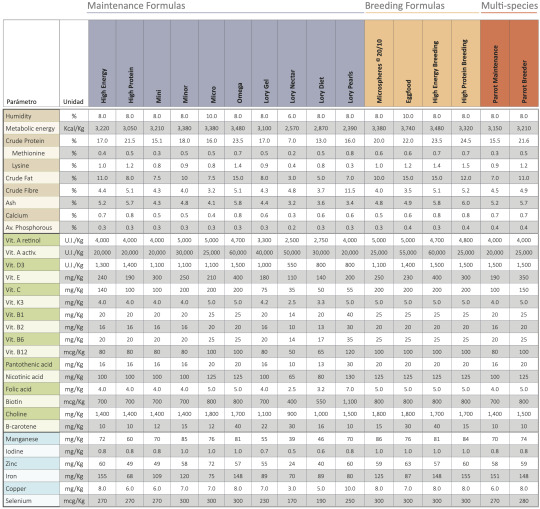
I am shocked by the responses I received. I am disappointed in parrot food manufacturers. I am frustrated with parrot food regulations.
I knew I wouldn't get much out of these emails since the standards for parrot food are so low but the amount of companies that just pretended not to get my emails or didn't even know what a feeding trial was is ridiculous. The amount of companies that were making claims that science can't back up, or making claims that science actually disagrees with is astounding.
The complete lack of transparency is terrifying.
#I am never doing this again#don’t ask questions to pet food companies they will try to throw you in jail#dude straight up was like WHAT WILL YOU DO WI THE THAT INFO YOURE NOT A VET???#HUH?????#feed my birds a diet that’s confirmed to be healthy for them……..#bring the data tm my vet and ask if this looks like a good option for my pets……#I will now be rethinking their diets entirely#thank you for coming to my ted talk#pellets#science
224 notes
·
View notes
Text
The Top 7 Best News of Last Week - August 15, 2022
📚 — Hope you had a great weekend. Let’s read some good news
1. Donations pour in after Michigan town defunded library over LGBTQ books

In the days after an Ottawa County community defunded its public library in a spat over LGBT-themed graphic novels, more than $50,000 in donations have poured in to help keep the doors open.
The donations to support Patmos Library in Jamestown Township, made to two GoFundMe campaigns run by local residents, had received donations from nearly 1,000 people as of early Sunday afternoon — just three days after the campaigns were launched Thursday. “It’s completely outdone any expectations I had,” said Jesse Dillman, organizer of one of the GoFundMe campaigns. “This is hugely encouraging.”
You can donate to the library here.
2. Colorado to end sales tax for period products, diapers this week
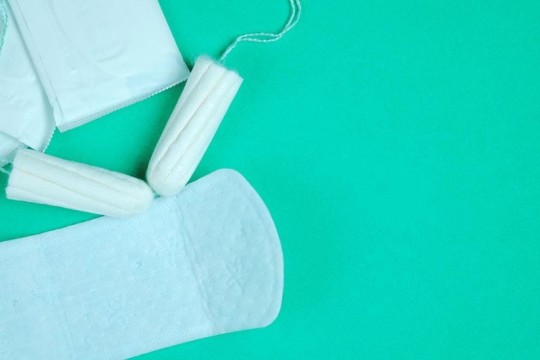
Coloradans will soon be able to purchase period products and diapers without paying state sales taxes, thanks to a new law taking effect Wednesday.
The law, House Bill 1055, expands sales tax exemptions for adult and youth diapers and period products including tampons, pads, menstrual cups, sponges, sanitary napkins and panty liners. Originally, the tax exemption was scheduled to begin in 2023, but it was amended in June to start on Aug. 10 instead.
3. California to become 1st state to offer free school lunches for all students

Beginning this school year, California will be the first state to implement the Universal Meals program, providing free meals to all schoolchildren. The program will make sure all kids have access to free meals at school. It’s a big win for the district and the students.
On average, 1 out of every 5 Californians does not know where their next meal will come from. So that’s why the Merced Union High School District’s director of nutritional services says health and equity are top of mind.
4. Cornea made from pig collagen gives people who were blind 20/20 vision

Corneas made from pig collagen have restored sight for people who were previously legally blind or visually impaired. Two years after the operations, none of the recipients have reported serious complications or adverse side effects.
Mehrdad Rafat at Linköping University in Sweden and his colleagues manufactured a flexible yet resilient dome that resembles a contact lens by extracting and purifying collagen from porcine skin. Following successful trials, the team began testing the artificial corneas in human volunteers.
All 20 people in the trial had corneal blindness due to keratoconus, a condition in which the cornea thins and bulges outward from the centre of the eye. Fourteen were legally blind before the operation and six had severely impaired sight. Afterwards, everyone had improved vision. Three of the formerly blind participants had 20/20 vision following the procedure.
5. 12yo boy with his bodyboard saved a family of four from drowning in the sea

This Sunday in Biarritz (France, big surfing spot with huge waves), a family was in a dangerous area, about to be carried away by the sea, the father and his 5yo boy were drowning, the mother and the other kid found a very small rock to saved their life but the waves were crushing them. A 12yo body boarder saw them from afar, swam to them at full speed and thanks to his body-board, could grab them. A few minutes later more help came and everyone was happily saved.
6. Thousands of beagles saved from drug trials in US

Nearly 4,000 beagles are looking for new homes after what is thought to be one of the biggest ever dog rescue efforts in the US. The dogs were being bred at a facility in Virginia that then sold them on to laboratories for drug experiments.
But the company has now been shut down because of animal rights violations — and charities are on a mission to rehome the dogs. The breeding facility in Cumberland, owned by company Envigo RMS, was sued in May by the US Department of Justice which accused it of multiple acts of animal cruelty.
7. Rare albino hedgehog saved from ‘death’s door’ after being rescued by 6-year-old boy

A rare albino hedgehog has been rescued from a village in north Wales after his mother was killed in a gardening accident. The male hoglet, who has been named Bean, was discovered in the village of Clocaenog, Denbighshire. He is thought to be just seven or eight weeks old.

That’s it for this week. This newsletter will always be free. If you liked this post you can support me with a small kofi donation:
Buy me a coffee ❤️
Have a great week ahead.
305 notes
·
View notes
Text
Brazilians Are Startled by High Levels of Sugar, Fat, and Salt in Food after New Labeling
Research shows that 56% noticed the warning on the packaging and, of these, 46% decided not to buy or will reduce consumption

Silvia Martins, 43, was certain that the cassava flour biscuit was "harmless" for her young daughters. However, the last time she went to the supermarket, she found a black label on the product with the warning: "High in saturated fat and sodium."
The new nutritional labeling for processed and ultra-processed foods, which warns about high levels of added sugar, saturated fat, and sodium, became mandatory last October, after nine years of debate between Anvisa (National Health Surveillance Agency), manufacturers, and civil society organizations.
Continue reading.
7 notes
·
View notes
Note
Bread is a staple food prepared from a dough of flour (usually wheat) and water, usually by baking. Throughout recorded history and around the world, it has been an important part of many cultures' diet. It is one of the oldest human-made foods, having been of significance since the dawn of agriculture, and plays an essential role in both religious rituals and secular culture.
Bread may be leavened by naturally occurring microbes (e.g. sourdough), chemicals (e.g. baking soda), industrially produced yeast, or high-pressure aeration, which creates the gas bubbles that fluff up bread. In many countries, commercial bread often contains additives to improve flavor, texture, color, shelf life, nutrition, and ease of production.
Etymology
The Old English word for bread was hlaf (hlaifs in Gothic: modern English loaf), which appears to be the oldest Teutonic name.[1] Old High German hleib[2] and modern German Laib derive from this Proto-Germanic word, which was borrowed into some Slavic (Czech: chléb, Polish: bochen chleba, Russian: khleb) and Finnic (Finnish: leipä, Estonian: leib) languages as well. The Middle and Modern English word bread appears in Germanic languages, such as West Frisian: brea, Dutch: brood, German: Brot, Swedish: bröd, and Norwegian and Danish: brød; it may be related to brew or perhaps to break, originally meaning "broken piece", "morsel".[3][better source needed]
History
Main article: History of bread
Bread is one of the oldest prepared foods. Evidence from 30,000 years ago in Europe and Australia revealed starch residue on rocks used for pounding plants.[4][5] It is possible that during this time, starch extract from the roots of plants, such as cattails and ferns, was spread on a flat rock, placed over a fire and cooked into a primitive form of flatbread. The oldest evidence of bread-making has been found in a 14,500-year-old Natufian site in Jordan's northeastern desert.[6][7] Around 10,000 BC, with the dawn of the Neolithic age and the spread of agriculture, grains became the mainstay of making bread. Yeast spores are ubiquitous, including on the surface of cereal grains, so any dough left to rest leavens naturally.[8]Woman baking bread (c. 2200 BC); Louvre
An early leavened bread was baked as early as 6000 BC in southern Mesopotamia, cradle of the Sumerian civilization, who may have passed on the knowledge to the Egyptians around 3000 BC. The Egyptians refined the process and started adding yeast to the flour. The Sumerians were already using ash to supplement the dough as it was baked.[9]
There were multiple sources of leavening available for early bread. Airborne yeasts could be harnessed by leaving uncooked dough exposed to air for some time before cooking. Pliny the Elder reported that the Gauls and Iberians used the foam skimmed from beer, called barm, to produce "a lighter kind of bread than other peoples" such as barm cake. Parts of the ancient world that drank wine instead of beer used a paste composed of grape juice and flour that was allowed to begin fermenting, or wheat bran steeped in wine, as a source for yeast. The most common source of leavening was to retain a piece of dough from the previous day to use as a form of sourdough starter, as Pliny also reported.[10][11]
The ancient Egyptians, Greeks, and Romans all considered the degree of refinement in the bakery arts as a sign of civilization.[9]
The Chorleywood bread process was developed in 1961; it uses the intense mechanical working of dough to dramatically reduce the fermentation period and the time taken to produce a loaf. The process, whose high-energy mixing allows for the use of grain with a lower protein content, is now widely used around the world in large factories. As a result, bread can be produced very quickly and at low costs to the manufacturer and the consumer. However, there has been some criticism of the effect on nutritional value.[12][13][14]
Types
Main article: List of breads
Brown bread (left) and whole grain bread
Dark sprouted bread
Ruisreikäleipä, a flat rye flour loaf with a hole
Bread is the staple food of the Middle East, Central Asia, North Africa, Europe, and in European-derived cultures such as those in the Americas, Australia, and Southern Africa. This is in contrast to parts of South and East Asia, where rice or noodles are the staple. Bread is usually made from a wheat-flour dough that is cultured with yeast, allowed to rise, and baked in an oven. Carbon dioxide and ethanol vapors produced during yeast fermentation result in bread's air pockets.[15] Owing to its high levels of gluten (which give the dough sponginess and elasticity), common or bread wheat is the most common grain used for the preparation of bread, which makes the largest single contribution to the world's food supply of any food.[16]Sangak, an Iranian flatbreadStrucia — a type of European sweet bread
Bread is also made from the flour of other wheat species (including spelt, emmer, einkorn and kamut).[17] Non-wheat cereals including rye, barley, maize (corn), oats, sorghum, millet and rice have been used to make bread, but, with the exception of rye, usually in combination with wheat flour as they have less gluten.[18]
Gluten-free breads are made using flours from a variety of ingredients such as almonds, rice, sorghum, corn, legumes such as beans, and tubers such as cassava. Since these foods lack gluten, dough made from them may not hold its shape as the loaves rise, and their crumb may be dense with little aeration. Additives such as xanthan gum, guar gum, hydroxypropyl methylcellulose (HPMC), corn starch, or eggs are used to compensate for the lack of gluten.[19][20][21][22]
Properties
Physical-chemical composition
In wheat, phenolic compounds are mainly found in hulls in the form of insoluble bound ferulic acid, where it is relevant to wheat resistance to fungal diseases.[23]
Rye bread contains phenolic acids and ferulic acid dehydrodimers.[24]
Three natural phenolic glucosides, secoisolariciresinol diglucoside, p-coumaric acid glucoside and ferulic acid glucoside, can be found in commercial breads containing flaxseed.[25]Small home made bread with pumpkin and sunflower seeds
Glutenin and gliadin are functional proteins found in wheat bread that contribute to the structure of bread. Glutenin forms interconnected gluten networks within bread through interchain disulfide bonds.[26] Gliadin binds weakly to the gluten network established by glutenin via intrachain disulfide bonds.[26] Structurally, bread can be defined as an elastic-plastic foam (same as styrofoam). The glutenin protein contributes to its elastic nature, as it is able to regain its initial shape after deformation. The gliadin protein contributes to its plastic nature, because it demonstrates non-reversible structural change after a certain amount of applied force. Because air pockets within this gluten network result from carbon dioxide production during leavening, bread can be defined as a foam, or a gas-in-solid solution.[27]
Acrylamide, like in other starchy foods that have been heated higher than 120 °C (248 °F), has been found in recent years to occur in bread. Acrylamide is neurotoxic, has adverse effects on male reproduction and developmental toxicity and is carcinogenic. A study has found that more than 99 percent of the acrylamide in bread is found in the crust.[28]
A study by the University of Hohenheim found that industrially produced bread typically has a high proportion of FODMAP carbohydrates due to a short rising time (often only one hour). The high proportion of FODMAP carbohydrates in such bread then causes flatulence. This is particularly problematic in intestinal diseases such as irritable bowel syndrome. While in traditional bread making the dough rises for several hours, industrial breads rise for a much shorter time, usually only one hour. However, a sufficiently long rising time is important to break down the indigestible FODMAP carbohydrates. Some flours (for example, spelt, emmer and einkorn) contain fewer FODMAPs, but the difference between grain types is relatively small (between 1 and 2 percent by weight). Instead, 90% of the FODMAPs that cause discomfort can be broken down during a rising time of 4 hours. In the study, whole-grain yeast doughs were examined after different rising times; the highest level of FODMAPs was present after one hour in each case and decreased thereafter. The study thus shows that it is essentially the baking technique and not the type of grain that determines whether a bread is well tolerated or not. A better tolerance of bread made from original cereals can therefore not be explained by the original cereal itself, but rather by the fact that traditional, artisanal baking techniques are generally used when baking original cereals, which include a long dough process. The study also showed that a long rising time also breaks down undesirable phytates more effectively, flavors develop better, and the finished bread contains more biologically accessible trace elements.[29][30]
Culinary uses
Bread pudding
Bread can be served at many temperatures; once baked, it can subsequently be toasted. It is most commonly eaten with the hands, either by itself or as a carrier for other foods. Bread can be spread with butter, dipped into liquids such as gravy, olive oil, or soup;[31] it can be topped with various sweet and savory spreads, or used to make sandwiches containing meats, cheeses, vegetables, and condiments.[32]
Bread is used as an ingredient in other culinary preparations, such as the use of breadcrumbs to provide crunchy crusts or thicken sauces; toasted cubes of bread, called croutons, are used as a salad topping; seasoned bread is used as stuffing inside roasted turkey; sweet or savoury bread puddings are made with bread and various liquids; egg and milk-soaked bread is fried as French toast; and bread is used as a binding agent in sausages, meatballs and other ground meat products.[33]
Nutritional significance
Bread is a good source of carbohydrates and micronutrients such as magnesium, iron, selenium, and B vitamins. Whole grain bread is a good source of dietary fiber and all breads are a common source of protein in the diet, though not a rich one.[34][35]
Crust
Crust of a cut bread made of whole-grainrye with crust crack (half right at the top)
Bread crust is formed from surface dough during the cooking process. It is hardened and browned through the Maillard reaction using the sugars and amino acids due to the intense heat at the bread surface. The crust of most breads is harder, and more complexly and intensely flavored, than the rest. Old wives' tales suggest that eating the bread crust makes a person's hair curlier.[36] Additionally, the crust is rumored to be healthier than the remainder of the bread. Some studies have shown that this is true as the crust has more dietary fiber and antioxidants such as pronyl-lysine.[37]
Preparation
Steps in bread making, here for an unleavened Chilean tortilla
Doughs are usually baked, but in some cuisines breads are steamed (e.g., mantou), fried (e.g., puri), or baked on an unoiled frying pan (e.g., tortillas). It may be leavened or unleavened (e.g. matzo). Salt, fat and leavening agents such as yeast and baking soda are common ingredients, though bread may contain other ingredients, such as milk, egg, sugar, spice, fruit (such as raisins), vegetables (such as onion), nuts (such as walnut) or seeds (such as poppy).[38]
Methods of processing dough into bread include the straight dough process, the sourdough process, the Chorleywood bread process and the sponge and dough process.Baking bread in East Timor
Formulation
Professional bread recipes are stated using the baker's percentage notation. The amount of flour is denoted to be 100%, and the other ingredients are expressed as a percentage of that amount by weight. Measurement by weight is more accurate and consistent than measurement by volume, particularly for dry ingredients. The proportion of water to flour is the most important measurement in a bread recipe, as it affects texture and crumb the most. Hard wheat flours absorb about 62% water, while softer wheat flours absorb about 56%.[39] Common table breads made from these doughs result in a finely textured, light bread. Most artisan bread formulas contain anywhere from 60 to 75% water. In yeast breads, the higher water percentages result in more CO2 bubbles and a coarser bread crumb.
Dough recipes commonly call for 500 grams (about 1.1 pounds) of flour, which yields a single loaf of bread or two baguettes.
Calcium propionate is commonly added by commercial bakeries to retard the growth of molds.[citation needed]
Flour
Main article: Flour
Flour is grain ground into a powder. Flour provides the primary structure, starch and protein to the final baked bread. The protein content of the flour is the best indicator of the quality of the bread dough and the finished bread. While bread can be made from all-purpose wheat flour, a specialty bread flour, containing more protein (12–14%), is recommended for high-quality bread. If one uses a flour with a lower protein content (9–11%) to produce bread, a shorter mixing time is required to develop gluten strength properly. An extended mixing time leads to oxidization of the dough, which gives the finished product a whiter crumb, instead of the cream color preferred by most artisan bakers.[40]
Wheat flour, in addition to its starch, contains three water-soluble protein groups (albumin, globulin, and proteoses) and two water-insoluble protein groups (glutenin and gliadin). When flour is mixed with water, the water-soluble proteins dissolve, leaving the glutenin and gliadin to form the structure of the resulting bread. When relatively dry dough is worked by kneading, or wet dough is allowed to rise for a long time (see no-knead bread), the glutenin forms strands of long, thin, chainlike molecules, while the shorter gliadin forms bridges between the strands of glutenin. The resulting networks of strands produced by these two proteins are known as gluten. Gluten development improves if the dough is allowed to autolyse.[41]
Liquids
Water, or some other liquid, is used to form the flour into a paste or dough. The weight or ratio of liquid required varies between recipes, but a ratio of three parts liquid to five parts flour is common for yeast breads.[42] Recipes that use steam as the primary leavening method may have a liquid content in excess of one part liquid to one part flour. Instead of water, recipes may use liquids such as milk or other dairy products (including buttermilk or yogurt), fruit juice, or eggs. These contribute additional sweeteners, fats, or leavening components, as well as water.[43]
Fats or shortenings
Fats, such as butter, vegetable oils, lard, or that contained in eggs, affect the development of gluten in breads by coating and lubricating the individual strands of protein. They also help to hold the structure together. If too much fat is included in a bread dough, the lubrication effect causes the protein structures to divide. A fat content of approximately 3% by weight is the concentration that produces the greatest leavening action.[44] In addition to their effects on leavening, fats also serve to tenderize breads and preserve freshness.
Bread improvers
Main article: Bread improver
Bread improvers and dough conditioners are often used in producing commercial breads to reduce the time needed for rising and to improve texture and volume and to give antistaling effects. The substances used may be oxidising agents to strengthen the dough or reducing agents to develop gluten and reduce mixing time, emulsifiers to strengthen the dough or to provide other properties such as making slicing easier, or enzymes to increase gas production.[45]
Salt
Salt (sodium chloride) is very often added to enhance flavor and restrict yeast activity. It also affects the crumb and the overall texture by stabilizing and strengthening[46] the gluten. Some artisan bakers forego early addition of salt to the dough, whether wholemeal or refined, and wait until after a 20-minute rest to allow the dough to autolyse.[47]
Mixtures of salts are sometimes employed, such as employing potassium chloride to reduce the sodium level, and monosodium glutamate to give flavor (umami).
Leavening
See also: Unleavened breadA dough trough, located in Aberdour Castle, once used for leavening bread
Leavening is the process of adding gas to a dough before or during baking to produce a lighter, more easily chewed bread. Most bread eaten in the West is leavened.[48]
Chemicals
A simple technique for leavening bread is the use of gas-producing chemicals. There are two common methods. The first is to use baking powder or a self-raising flour that includes baking powder. The second is to include an acidic ingredient such as buttermilk and add baking soda; the reaction of the acid with the soda produces gas.[48] Chemically leavened breads are called quick breads and soda breads. This method is commonly used to make muffins, pancakes, American-style biscuits, and quick breads such as banana bread.
Yeast
Main article: Baker's yeastCompressed fresh yeast
Many breads are leavened by yeast. The yeast most commonly used for leavening bread is Saccharomyces cerevisiae, the same species used for brewing alcoholic beverages. This yeast ferments some of the sugars producing carbon dioxide. Commercial bakers often leaven their dough with commercially produced baker's yeast. Baker's yeast has the advantage of producing uniform, quick, and reliable results, because it is obtained from a pure culture.[48] Many artisan bakers produce their own yeast with a growth culture. If kept in the right conditions, it provides leavening for many years.[49]
The baker's yeast and sourdough methods follow the same pattern. Water is mixed with flour, salt and the leavening agent. Other additions (spices, herbs, fats, seeds, fruit, etc.) are not needed to bake bread, but are often used. The mixed dough is then allowed to rise one or more times (a longer rising time results in more flavor, so bakers often "punch down" the dough and let it rise again), loaves are formed, and (after an optional final rising time) the bread is baked in an oven.[48]
Many breads are made from a "straight dough", which means that all of the ingredients are combined in one step, and the dough is baked after the rising time;[48] others are made from a "pre-ferment" in which the leavening agent is combined with some of the flour and water a day or so ahead of baking and allowed to ferment overnight. On the day of baking, the rest of the ingredients are added, and the process continues as with straight dough. This produces a more flavorful bread with better texture. Many bakers see the starter method as a compromise between the reliable results of baker's yeast and the flavor and complexity of a longer fermentation. It also allows the baker to use only a minimal amount of baker's yeast, which was scarce and expensive when it first became available. Most yeasted pre-ferments fall into one of three categories: "poolish" or "pouliche", a loose-textured mixture composed of roughly equal amounts of flour and water (by weight); "biga", a stiff mixture with a higher proportion of flour; and "pâte fermentée", which is a portion of dough reserved from a previous batch.[50][51]
Before first rising
After first rising
After proofing, ready to bake
Sourdough
Main article: SourdoughSourdough loaves
Sourdough is a type of bread produced by a long fermentation of dough using naturally occurring yeasts and lactobacilli. It usually has a mildly sour taste because of the lactic acid produced during anaerobic fermentation by the lactobacilli. Longer fermented sourdoughs can also contain acetic acid, the main non-water component of vinegar.[52][53][54]
Sourdough breads are made with a sourdough starter. The starter cultivates yeast and lactobacilli in a mixture of flour and water, making use of the microorganisms already present on flour; it does not need any added yeast. A starter may be maintained indefinitely by regular additions of flour and water. Some bakers have starters many generations old, which are said to have a special taste or texture.[52] At one time, all yeast-leavened breads were sourdoughs. Recently there has been a revival of sourdough bread in artisan bakeries.[55]
Traditionally, peasant families throughout Europe baked on a fixed schedule, perhaps once a week. The starter was saved from the previous week's dough. The starter was mixed with the new ingredients, the dough was left to rise, and then a piece of it was saved to be the starter for next week's bread.[48]
Steam
The rapid expansion of steam produced during baking leavens the bread, which is as simple as it is unpredictable. Steam-leavening is unpredictable since the steam is not produced until the bread is baked. Steam leavening happens regardless of the raising agents (baking soda, yeast, baking powder, sour dough, beaten egg white) included in the mix. The leavening agent either contains air bubbles or generates carbon dioxide. The heat vaporises the water from the inner surface of the bubbles within the dough. The steam expands and makes the bread rise. This is the main factor in the rising of bread once it has been put in the oven.[56] CO2 generation, on its own, is too small to account for the rise. Heat kills bacteria or yeast at an early stage, so the CO2 generation is stopped.
Bacteria
Salt-rising bread does not use yeast. Instead, it is leavened by Clostridium perfringens, one of the most common sources of food-borne illness.[57][58]
Aeration
Aerated bread is leavened by carbon dioxide being forced into dough under pressure. From the mid-19th to mid-20th centuries, bread made this way was somewhat popular in the United Kingdom, made by the Aerated Bread Company and sold in its high-street tearooms. The company was founded in 1862, and ceased independent operations in 1955.[59]
The Pressure-Vacuum mixer was later developed by the Flour Milling and Baking Research Association for the Chorleywood bread process. It manipulates the gas bubble size and optionally the composition of gases in the dough via the gas applied to the headspace.[60]
Cultural Significance
A Ukrainian woman in national dress welcoming with bread and salt
Main article: Bread in culture
Bread has a significance beyond mere nutrition in many cultures because of its history and contemporary importance. Bread is also significant in Christianity as one of the elements (alongside wine) of the Eucharist,[61] and in other religions including Paganism.[62]
In many cultures, bread is a metaphor for basic necessities and living conditions in general. For example, a "bread-winner" is a household's main economic contributor and has little to do with actual bread-provision. This is also seen in the phrase "putting bread on the table". The Roman poet Juvenal satirized superficial politicians and the public as caring only for "panem et circenses" (bread and circuses).[63] In Russia in 1917, the Bolsheviks promised "peace, land, and bread."[64][65] The term "breadbasket" denotes an agriculturally productive region. In parts of Northern, Central, Southern and Eastern Europe bread and salt is offered as a welcome to guests.[66] In India, life's basic necessities are often referred to as "roti, kapra aur makan" (bread, cloth, and house).[67]
Words for bread, including "dough" and "bread" itself, are used in English-speaking countries as synonyms for money.[1] A remarkable or revolutionary innovation may be called the best thing since "sliced bread".[68] The expression "to break bread with someone" means "to share a meal with someone".[69] The English word "lord" comes from the Anglo-Saxon hlāfweard, meaning "bread keeper."[70]
Bread is sometimes referred to as "the staff of life", although this term can refer to other staple foods in different cultures: the Oxford English Dictionary defines it as "bread (or similar staple food)".[71][72] This is sometimes thought to be a biblical reference, but the nearest wording is in Leviticus 26 "when I have broken the staff of your bread".[73] The term has been adopted in the names of bakery firms.[74]
See also
Food portal
Bark bread – Scandinavian bread used as famine food
Bread bowl – Round loaf of bread which has had a large portion of the middle cut out to create an edible bowl
Bread clip – Closure device for plastic bags
Bread dildo – Dildo prepared using bread, allegedly made in the Greco-Roman era around 2,000 years ago
Breading – Residue of dried bread
Bread machine – Type of home appliance for baking bread
Bread pan – Kitchen utensil
Crouton – Rebaked breads
List of breads
List of bread dishes – Dishes using bread as a main ingredient, listed by category
List of toast dishes
Quick bread – Bread leavened with agents other than yeast
Sliced bread – Loaf of bread that has been sliced with a machine
Slow Bread – Type of bread made using very little yeast
Sop – Piece of bread or toast that is drenched in liquid and then eaten.
Stuffing – Edible mixture filling a food's cavity
White bread – Type of bread made from white wheat flour
oh fuck yes bread
5 notes
·
View notes
Text
What is protein & Why do you need it in your diet?
When it comes to becoming a Fit Girl, adding protein to your diet is essential. 🍳 Protein helps keep you feeling full for longer, which can help you resist unhealthy snacks or overeating. Protein also helps you build muscle and keeps your energy levels up during workouts.
Protein is an important nutrient that helps our bodies function at their best. It’s in every cell of our body and helps build and repair muscles, bones, skin, hair👱♀️, and other tissues.
It also helps produce hormones and enzymes that regulate how we process food and the energy we get from it.
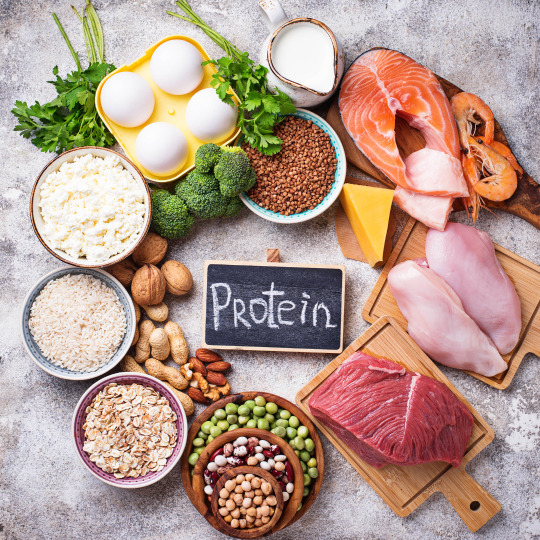
Protein is especially important for young women who want to become or stay fit. Fitness goals like building muscle💪🏽, losing fat, gaining endurance, and maintaining a healthy weight require an adequate protein intake. You will see results much quicker that way.
It’s important to get enough—but not too much—protein in your diet. Eating large amounts of high-protein foods can lead to health issues over time, such as digestion problems.
How much protein to take then? It's the million dollar question💸 in fitness and health circles. Personally, I have found that 0.8–1g of protein per kilogram of body weight each day works for me. I see results from exercise and nutrition, and my digestion is fine. However, many sources recommend 0.8–1g per lbs of body weight per day or even more.
Because recommendations vary wildly (many scientific studies recommending a higher intake are funded by or connected to protein supplement manufacturers), I suggest tracking your protein intake for a few weeks and checking if you are seeing your desired results.✔️ If not, try upping your protein intake.

Eating a variety of high-quality proteins, like lean poultry🍗 and fish, eggs🥚, beans, nuts, legumes and dairy products can help you get the right amount of protein. If you’re having trouble reaching your goals with food alone, consider adding a protein supplement🥛 to your diet. These are available for vegetarians and vegans too.
By incorporating the right amount of protein into your diet, you can reach your fitness goals and stay healthy at the same time✨. So don’t forget about this important nutrient when you’re planning your fit girl meals and snacks. Your body will thank you.
Good luck!
Did you find this post useful? Please reblog it.
Check out my other Fit Girl guides.
#protein#nutrition#green juice girl#that girl#it girl#pink pilates princess#clean girl#health and wellness#healthy#healthy living#healthy weight loss#health#healthy tips#healthy diet#healthy lifestyle#healthy life tips#levelup#leveling up#level up journey#weightlosstips#lose weight#dream body#dream girl#self improvement#wellnes journey#health journey#healthy habits#healthblr#fitblr#weight loss
45 notes
·
View notes
Text
Hellooooo my Anna friends!
So I wanted to make a little informative post on how to correctly read nutrition labels!!!! Above is my source ✌️😤 with all the science words and hard facts from the FDA, if you wanna read the big version go for it…..other wise ima simplify it for ya!
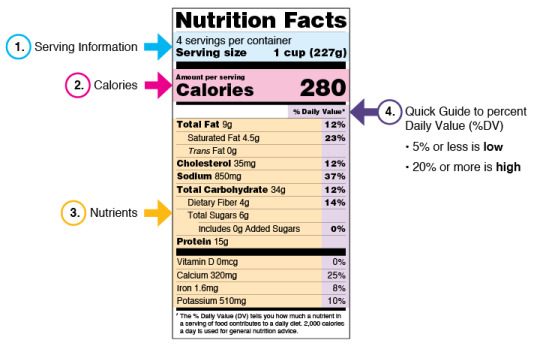
1- serving size
This is our guide to how many calories and nutritions are in the food, quantifying it (turning it into a measurable number). A serving size is the guide to the rest of the label! It tells you how much of the package the label is talking about- our example has a serving size of 1 cup meaning per ever one cup there is 280 calories and so forth with the nutritional numbers too!
TIP- one big way that brands will get you is in serving sizes- ex: bands will say 0 calories but then have 100000000 servings because you can legally label a food item as 0 calories if it has less than 5 calories! So if you grab a zero calorie item look at the serving to see if it has a huge number and multiply that by 2 or 3 and that’s the total number of calories per container- or you can find out what amount actually has the “0” calories (1-4 cals) by checking the amount per serving, likely being 1g or 1 tsp ——- ( irl example tic tacs are “0” cals but really have about 2-4 calories per mint through this loophole)
2. Calories-
I think I maybe don’t have to explain this… its calories and rember this is per serving, so per our example that would be one cup / 277 grams
3. Nutrients 4. Daily value
Okay here is the fun stuff —— nutrients are the things we need to function properly, with an Ed it is preferable you take more of what you’ll lack by extreme dieting and stay away from already known “bad” nutrients. Now all of these numbers and grams probably mean nothing to you and that’s totally fine, but look out for large amounts of sodium, added sugars, trans fats, and cholesterol! But you may be wondering how to know what’s “big”. Looking over at the daily value section will tell you this. Think of you nutrition requirements as a percentage, to be fully filled in a day you would get 100%. Daily value is a fraction of that, in our example has 320mg of calcium, which equates to 25% of the daily value. Now if you were to have one serving you will have filled up taht 25% and still have 75% to fill, similarly if you eat four servings then that is 100% and therefore all the calcium you need in a day! ———picture below is a visual example using sodium

Other additional information
g= grams! A common weight based measurement that can be taken on a scale! If you don’t have a scale a quick google search can help you find out how to approximate this via size, amount of food, or volume (cups etc)
Mg= milligrams, also a weight measurement, you likely won’t need unless you plan on taking vitamins- in which case the labels should tell you how much is needed daily in a similar fashion
Total sugars and added sugars - total sugars refers to the amount of all sugars in a product, there are two types of sugars -one that come from the product and added ones. Normal sugars are from the natural sugars like sweetness in fruits or coconut water but added sugars are from the manufactures, this includes syrups, sugars, honeys, and juices (think high fructose corn syrup). our label in the example only has normal sugars so all of them are form the original food, in other labels it will appear as a “fraction” ex total sugars- 15g added sugars -5g this means that there are 5g added but only 10g normal sugars (cus you subtract)
~~~If you would like me to do another part going into deatil on good/ bad nutrients as well as what vitamins I would recommend (and use) I absolutely can!! (With long explanations on why again as well hehehe) 💋💕❤️💋💕❤️
#tw 3d vent#⭐️ve#3dtumblr#@nor3×14#low cal restriction#tw ed but not sheeran#tw restriction#ana0rex1a#🕯️as a feather#3d diary#tw ana diary#ana bllog#3d di3t#3ating d1sorder#4n0r3xia#4ana#4norexi4#@na trigger#@n0r3xia#@na tips#@na motivation#@tw edd#@na vent#@nor3xia#@4norexi4#@ana#@n@ diary#@na blog#@n@ tips#i wanna ⭐️ve
5 notes
·
View notes
Link

#nutraceutical product development#developing nutraceutical product development#nutraceutical formulation#nutraceutical formulation development#dietary supplements#food supplement#nutritional supplements#nutraceutical contract manufacturing#nutraceutical product formulation#nutraceutical product development service
0 notes
Text
There is a lot of misinformation when it comes to pet food, I hope this can shed some light.
- Grains are necessary (Unless diagnosed with grain allergies by a veterinarian).
- Raw isn't always best. (Raw/home cooked diets need to be properly formulated by a board certified nutritionist to be balanced, more information below).
- Grain free can be dangerous.
- The vast majority of companies do not follow WSAVA guidelines.
- Veterinarians DO NOT get kick backs from suggesting food. How are they going to get a kickback from a food you didn't even buy from them? If anything, the pet store employees are getting kick backs for suggesting foods!
The “Big Five” Brands are the five brands that adhere to WSAVA guidelines (World Small Animal Veterinary Association).
Which are:
- Employs one or more full-time qualified nutritionist(s) and willingly discloses their credentials.
- Foods are formulated by a qualified team of professionals such as nutritionists, toxicologists, food scientists etc.
- Undergoes feeding trials that meet or exceed AAFCO standards, for most or all formulations.
- Foods are produced and manufactured in US facilities, owned and operated by the manufacturer, or under close supervision of the manufacturer. Equipped with machinery, laboratories and staff that provide extensive on-site quality assurance.
- Provides detailed description on quality control protocol. Selection criteria for partners, analysis and sample tracking of externally sourced ingredients, daily safety checks of product batches and facilities, physical inspection, key nutrient testing before final packing.
- Provides exact number for any nutrient on an energy basis (grams per kcal).
- Readily provides kcal content per gram and per cup.
- Conducts research relevant to nutrition, products marketed, and product claims. Publishes research in peer-reviewed journals.
So let’s get to it.
The “Big Five” Brands are:
Royal Canin - Breed specific lines that were created in conjunction with breeders and veterinarians, general health lines and targeted health lines + RX diets
Eukanuba - Owned by Royal Canin, mainly their performance lines + general health lines
Purina - Sport lines, general health lines, targeted health lines, most accessible and cost effective + RX diets
IAMS - General health lines, cost effective, easily accessible
Hills Pet - General health lines, targeted health lines + RX diets
If you’d like to do some reading…
Here are multiple links for kibble, raw diets, grain free vs grain inclusive, Diet Associated DCM and WSAVA.
Peer reviewed resources on dog kibble:
https://vetnutrition.tufts.edu/2019/03/stop-reading-your-pet-food-ingredient-list/
https://vetnutrition.tufts.edu/2016/06/why-you-shouldnt-judge-a-pet-food-by-its-ingredient-list/
https://vetnutrition.tufts.edu/2019/12/pet-food-decisions-how-do-you-pick-your-pets-food/
https://vet.osu.edu/vmc/companion/our-services/nutrition-support-service/myths-and-misconceptions-surrounding-pet-foods
https://www.aaha.org/publications/newstat/articles/2017-01/myth-busters-corn-edition/
Peer reviewed resources on raw diets:
https://vetnutrition.tufts.edu/2016/01/raw-diets-a-healthy-choice-or-a-raw-deal/
https://www.ncbi.nlm.nih.gov/pmc/articles/PMC3003575/
https://www.veterinarypracticenews.com/debating-raw-diets-january-2019/
STOLEN FROM HERE
144 notes
·
View notes